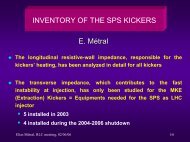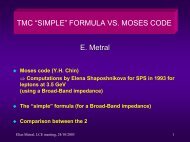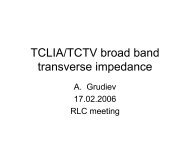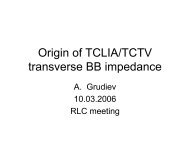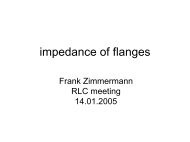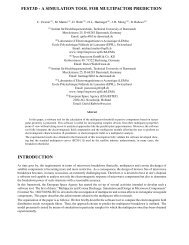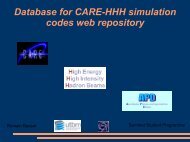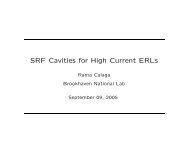Photoionization Cross Sections of He and H2
Photoionization Cross Sections of He and H2
Photoionization Cross Sections of He and H2
Create successful ePaper yourself
Turn your PDF publications into a flip-book with our unique Google optimized e-Paper software.
No. 2, 1998 PHOTOIONIZATION CROSS SECTIONS OF <strong>He</strong> AND H 2<br />
1047<br />
<strong>Cross</strong> Section(barn)*(Energy (eV)) 7/2<br />
10 14<br />
10 13<br />
10 12<br />
10 11<br />
<strong>He</strong><br />
NIST − 97<br />
<strong>He</strong>nke−93<br />
Present<br />
10 1 10 2 10 3 10 4 10 5<br />
Photon Energy (eV)<br />
FIG. 2.ÈRecommended photoionization cross section for <strong>He</strong> in the<br />
form E7@2p(E). Also shown are the data <strong>of</strong> <strong>He</strong>nke et al. (1993) <strong>and</strong> NIST<br />
(1997). The NIST results do not asymptotically tend to a constant.<br />
(According to a note on X-ray attenuation databases at NIST 1997, the<br />
photoabsorption results given there for helium are unreliable.)<br />
coefficients are approximately equal to the expansion coefficients<br />
for the exponential, [a , a2/2, [a3/3!.<br />
3 3 3<br />
Double photoionization <strong>of</strong> helium l ] <strong>He</strong> ] <strong>He</strong>2` ] 2e<br />
is included in the sum rules. It has received considerable<br />
attention (Ishihara, Hino, & McGuire 1991; Levin et al.<br />
1991, 1993; Bartlett et al. 1992; Dalgarno & Sadeghpour<br />
1992; Andersson & Burgdoerfer 1993; Kornberg & Miraglia<br />
1993; Hino 1993; Hino et al. 1993; Proulx & Shakeshaft<br />
1993; Berrah et al. 1993; Teng & Shakeshaft 1993,<br />
1994; Fan, Sadeghpour, & Dalgarno 1994; Azuma et al.<br />
1995; Sadeghpour 1996), because it provides a direct<br />
measure <strong>of</strong> the e†ect <strong>of</strong> electron correlation. At high energies,<br />
the ratio <strong>of</strong> the cross sections for double to single<br />
ionization tends to a constant value <strong>of</strong> 0.0164 (Dalgarno &<br />
Sadeghpour 1992; Forrey et al. 1995). As the energy<br />
decreases below 1 keV, the ratio increases to a maximum <strong>of</strong><br />
about 0.04 at 120 eV <strong>and</strong> then decreases sharply to zero at<br />
the threshold <strong>of</strong> 79.0 eV (Samson, Bartlett, & <strong>He</strong> 1992).<br />
In Figure 2 we show also the data from <strong>He</strong>nke, Gullikson,<br />
& Davis (1993) <strong>and</strong> NIST (1997). We believe that in the<br />
energy range from threshold to 600 eV, our cross sections<br />
have an uncertainty <strong>of</strong> less than 2%. The error in the photoabsorption<br />
cross sections at higher energies should be<br />
no more than 5% at any energy, <strong>and</strong> it is on average less<br />
than 2%.<br />
4. PHOTOIONIZATION OF MOLECULAR HYDROGEN<br />
Samson & Haddad (1994) have measured the photoabsorption<br />
cross sections <strong>of</strong> H at photon energies between 18<br />
<strong>and</strong> 113 eV to within an uncertainty 2<br />
<strong>of</strong> ^3%. There have<br />
been earlier measurements down to the threshold energy <strong>of</strong><br />
15.4 eV (Cook & Metzger 1964; Lee, Carlson, & Judge<br />
1976). The threshold region is complicated by the presence<br />
<strong>of</strong> autoionizing resonances arising from vibrationally<br />
excited Rydberg states whose detailed structure has not<br />
been fully analyzed (Dehmer & Chupka 1976; Dehmer et al.<br />
1992; Jungen, Pratt, & Ross 1995). Theoretical calculations<br />
(Ford, Docken, & Dalgarno 1975; Flannery, Tai, & Albritton<br />
1977; Cacelli, Moccia, & Rizzo 1993) yield an average<br />
cross section increasing from 1 ] 10~18 cm2 at threshold to<br />
1 ] 10~17 cm2 at 18 eV, where it agrees with the measurements<br />
<strong>of</strong> Samson & Haddad (1994). The increasing average<br />
cross section is a reÑection <strong>of</strong> the Franck-Condon overlap<br />
<strong>of</strong> the initial vA \ 0 vibrational wave function <strong>of</strong> H with the<br />
Ðnal v@ vibrational wave function <strong>of</strong> H The 2<br />
Franck-<br />
Condon factors maximize at v@ \ 2. 2`.<br />
Samson & Haddad (1994) have measured the cross sections<br />
between 18 <strong>and</strong> 113 eV <strong>and</strong> recommend cross sections<br />
out to 300 eV, which they believe to be uncertain by no<br />
more than 4%. Theoretical calculations (Ford et al. 1975;<br />
Flannery et al. 1977; OÏNeill & Reinhardt 1978) do not<br />
extend beyond 37 eV, except for the evaluation <strong>of</strong> Cooper<br />
(1974) <strong>and</strong> Sadeghpour & Dalgarno (1993) <strong>of</strong> the highenergy<br />
limiting nonrelativistic formula<br />
p (E) D 45.6 barns . (16)<br />
<strong>H2</strong> E(keV)7@2<br />
We attempt to make use <strong>of</strong> the sum rules to extend the cross<br />
sections <strong>of</strong> Samson & Haddad (1994) to the high-energy<br />
region. Sum rules for H have been obtained within the<br />
2<br />
Born-Oppenheimer approximation over an extended range<br />
<strong>of</strong> internuclear distance R by Wolniewicz (1993). The sums<br />
vary slowly with R in the Franck-Condon region, which<br />
extends from 1a to 2a , <strong>and</strong> the vibrational averages for<br />
0 0<br />
vA \ 0 do not di†er importantly from the values at the equilibrium<br />
internuclear distance <strong>of</strong> 1.4a . The sum rules are<br />
0<br />
given in Table 6. The value <strong>of</strong> ln 2K calculated by<br />
Wolniewicz (1993) makes use <strong>of</strong> an approximate representation<br />
<strong>of</strong> S(k) as a function <strong>of</strong> k (Dalgarno 1960; Garcia 1966;<br />
Bishop & Cheung 1978) <strong>of</strong> uncertain accuracy.<br />
Because <strong>of</strong> the nuclear motion, the near-threshold photoionization<br />
cross sections cannot be transformed directly<br />
into the electronic di†erential oscillator strengths that enter<br />
into the sum rules. Absorption occurs preferentially into the<br />
v@ \ 2 level <strong>of</strong> H once it becomes energetically accessible.<br />
As the photon energy 2`<br />
exceeds the vibrational energies, the<br />
TABLE 6<br />
VALUES OF SUM RULES FOR H 2<br />
Sum Rulea Exact Discrete 15.4È18 eV 18È115 eV 115È300 eV 300ÈO eV Total<br />
S([2) .......... 5.180 3.784 0.315 1.018 . . . . . . 5.117<br />
S([1) .......... 3.036 1.884 0.195 0.900 0.003 . . . 2.982<br />
S(0)............. 2 0.943 0.121 0.873 0.014 0.002 1.954<br />
S(1)............. 1.701 0.474 0.075 0.981 0.088 0.041 1.659<br />
S(2)............. 3.851 0.239 0.047 1.359 0.577 1.578 3.800<br />
S(2)ln(2K) ...... 8.911 [0.163 [0.022 0.638 1.108 7.405 8.966<br />
a These are the values <strong>of</strong> the electronic sum rules evaluated at the equilibrium separation. The value <strong>of</strong> S(2) ln 2K<br />
is an approximate estimate.



